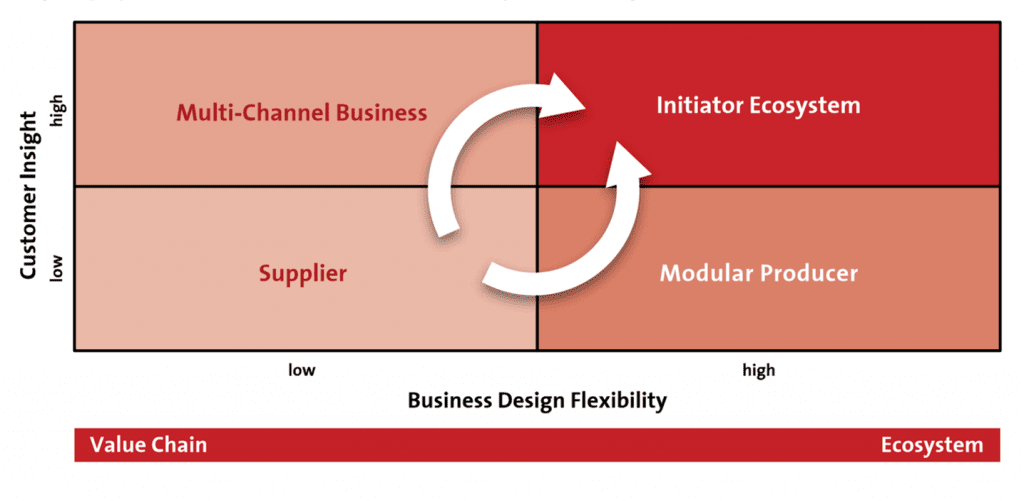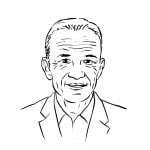The revolution that we are witnessing started with the hum of electricity and cooling fans. It has taken us from the mechanical to the digital age and, as with the Industrial Revolution, it marks a significant leap that affects every aspect of our daily life.
The digital revolution is accelerating at a breakneck speed and transforming business models. It is an age of collaboration – innovative technology partners can quickly turn a small bricks-and-mortar store into a global enterprise.
According to Weill and Woerner,[1] four different classes of business model can be distinguished, each of which implies significant differences in operating model, transformation strategy, scalability, etc. So it is wise to deliberately choose your arena.
In many respects the most promising class of business model is the ecosystem initiator. The initiator of an ecosystem owns the customer relationship and orchestrates various suppliers.
Smart players can maximise profits by exploiting the customer relationship and minimising costs along the supply chain.
Furthermore, the initiator of an ecosystem is able to shift risks to its suppliers and – if necessary – replace them. Therefore, many digital players aim for a dominant role in an ecosystem (see figure below).

Previously, the small bricks-and-mortar store could grow organically or through M&A – both of which can be slow, ineffective and value destroying. Linking enterprises to form digital ecosystems is seen as a third way to grow, not just moderately but exponentially. From Airbnb and Uber to Amazon and Alibaba, today’s big growth stars all share a key characteristic in their business models: they have created digital platforms that manage and monetise the vibrant ecosystem of consumers, producers and innovators.
How did Airbnb become the world’s biggest hotelier in a few short years with only 2,500 employees and without owning any hotels?
They did it by creating a digital platform that connects hosts (people with available rooms or accommodation) with travellers – the participants themselves interact and share in value creation.
These platforms, like the one Airbnb created and manages, are the basis of the business models of companies that are experiencing astronomical growth. Incumbent enterprises are trying to tap into these digital ecosystems because they see the potential to realise their ambitions almost instantly on a global scale, as compared to growth before digitalisation. In the majority of cases, a digital platform is the first step to initiating an ecosystem. Only when the platform is in place can you begin to attract suppliers and customers. BearingPoint research, for example, distinguishes four different platform categories: transaction platforms, innovation platforms, integrated platforms and investment platforms (see table below).[2]
Starting a platform presents a tricky chicken and egg problem. You must attract different partners, such as suppliers and customers, at the same time as making the platform attractive to all participants.
Not surprisingly, all-in-one solutions are already available on the market in the form of Digital Ecosystem Management (DEM), such as BearingPoint’s Infonova R6.
What is attractive for large enterprises, and even small bricks-and-mortar stores, is that DEM enables an enterprise to rapidly launch new services and service types, and manage and monetise an ecosystem of partners and third parties.
The example of a major telecommunications company illustrates how an enterprise can transform its business model through a DEM solution. This telco chose BearingPoint’s Infonova R6 as its DEM solution. The solution enhanced the telco’s data centre collocation and cloud services portfolio, which includes storage offerings as well as third-party software applications. It enabled the telco to seamlessly aggregate new cloud services and software applications so that it could then offer them as new products and services to customers who can now exploit the full benefits of cloud and digital transformation. The DEM solution empowered the telco to provide white-label facilities to third parties seeking to sell their own cloud and application services, and enabled them to offer and monetise their services as bundles in combination with the telco and other third-party services. In this way the solution ultimately opened new services and possibilities for the telco, both locally and globally, whereby the power of DEM solutions in general is that nearly all enterprises can add new services and service types. Infonova is only one example, as there are several other such solutions in existence today.
Linking enterprises to form digital ecosystems wipes out the previous boundaries of business models. Looking ahead, disruption is likely to be experienced across all traditional businesses.
The winners will be the companies that evolve their business models by forming ecosystems, and many of the traditional giant enterprises will become dinosaurs. The digital revolution will not wait and will only continue to accelerate.
_____
[1] Weill, P., Woerner, S. L.: ‘Thriving in an increasingly digital ecosystem’, MIT Sloan Management Review, Vol. 56, Iss. 4, 2015.
[2] Evans, P. C., Gawer, A.: ‘The Rise of the Platform Enterprise – A Global Survey’, BearingPoint, 2016.


